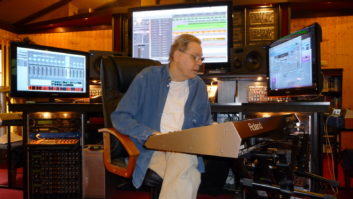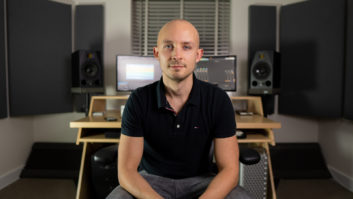Tim Showalter, the principal songwriter and musician behind Strand of Oaks, puts it all out on the table on his latest album, Heal—a treasure trove of cathartic emotion, all expressed through an delicious stew of vintage synthesizers and heavy guitars, with some ingredients courtesy of J Mascis (Dinosaur Jr.). In preparation for the album, Showalter claims he wrote 30 songs in three weeks as part of an all-out catharsis. In our conversation, he reveals how his personal struggles and unregimented approach to recording played an important role in helping him create a more expressive and authentic album.
ON GETTING THE RIGHT RECIPE:
For me, it felt like a coming of age in terms of how to fully realize a record. When I started making records, I didn’t really know what I was doing. I knew how to write songs and record them, but this was the first time that I had the confidence to create the music that I always wanted to make. I just wasn’t sure how to do it in the past because I had such limited knowledge—it took me three records to get the recipe right. It’s like I want to make this awesome chili, but my first tries at it weren’t exactly what I wanted. In the same way, I love my first few records, but this one had exactly the sound and style I wanted. There is such a big difference between wanting something and actually achieving it. And when it comes to a record, this is the first time I’ve been able to achieve it.
ON MAKING BEAUTY OUT OF CHAOS:
My head was in such a manic state of disarray and the rest of my life was in upheaval, but all this translated into perfect focus when it came to making the record. I really surprised me, because writing these songs was not a labor-intensive process. For example, I think I wrote three of the songs in one day, and not just lyrics and chords. I almost demoed them to completion. The writing process came so easily because I freed myself of any rules, any genre or sound limitations. I refer to it as my own personal mixtape, like the kind I used to make when I was a kid—but I wrote all the songs. I put in a super loud guitar with a punk sound, then a synthesizer. There were no rules on this record and it was ‘anything goes.’
ON BUILDING DEMOS:
On my previous records, before I started using Logic, I had no way of recording my own songs. I would just remember each of them as I had written them on the guitar. I would have the entire arrangement in my head, but it wouldn’t be until I got into the studio before I could realize this further. For this record, I got Logic, a simple MIDI controller, a basic condenser mic and a guitar DI. Once I started demoing, it felt so amazing to be programming drum parts, synthesizer parts and layering all these songs. This made the entire recording process very quick, because my Logic files then formed the skeleton of every song. When I got to the studio, we just removed and replaced tracks where needed, so every song I recorded was built from the original demo.
ON LOSING THE ‘SWITCH:’
When you switch from doing demos to going into the studio, you lose some of the initial innocence and energy that you had at the moment of creation. We never did that—so there was never that mark of ‘now it’s studio time.’ It was a smooth transition and I would say that about 30 percent of the record is the ‘demo’ material that we kept. For example, the main guitar solo on “Mirage Year” is what I recorded using a DI into Logic at home. When we got into the studio, we just re-amped the signal through a ton of pedals and through two huge old HiWatt amplifiers. That solo means so much to me because it was the first take in my bedroom—fingers bleeding, just digging into the guitar. I think I am going to make records like that from now on. It saves so much time, and it is like deconstructing a demo and building it back up.
ON PRODUCING AND MIXING:
Only Ben [Vehorn, of Tangerine Sound Studios in Akron, OH] understands what’s in my head. I will tell him I want the synthesizers to sound like two angels talking together in the cosmos, one is pink, and the other is blue. He’s like, “OK, I understand. I will just add a bit of compression and maybe turn up the plate reverb.” He’s able to translate everything that I am doing. When we were finished recording though, Ben and I made the correct decision to not mix it ourselves; we had to step away. John Congleton, who is one of my heroes in the recording world, ended up mixing it and we gave him plenty of leeway. He made the drums sound much better and the guitars sound bigger.
ON RECORDING WITH J MASCIS:
I didn’t know that JM was going to be on the record. It was one of those things that just happened. I have always been amazed by JM and his tone—it cuts like a dagger stabbing through the listening wall and stands apart in the mix so well. I have always held his tone in high regard and wondered how I could do that myself. One way I was able to do this in my own playing was by removing my dependency on reverb and delay. These tools are so easy to use and they make you think you sound better—but in reality, you are just hiding things. We ended up removing about 90 percent of the reverb on the record, so it is very dry; I think this is what helped the mixing process so much.





